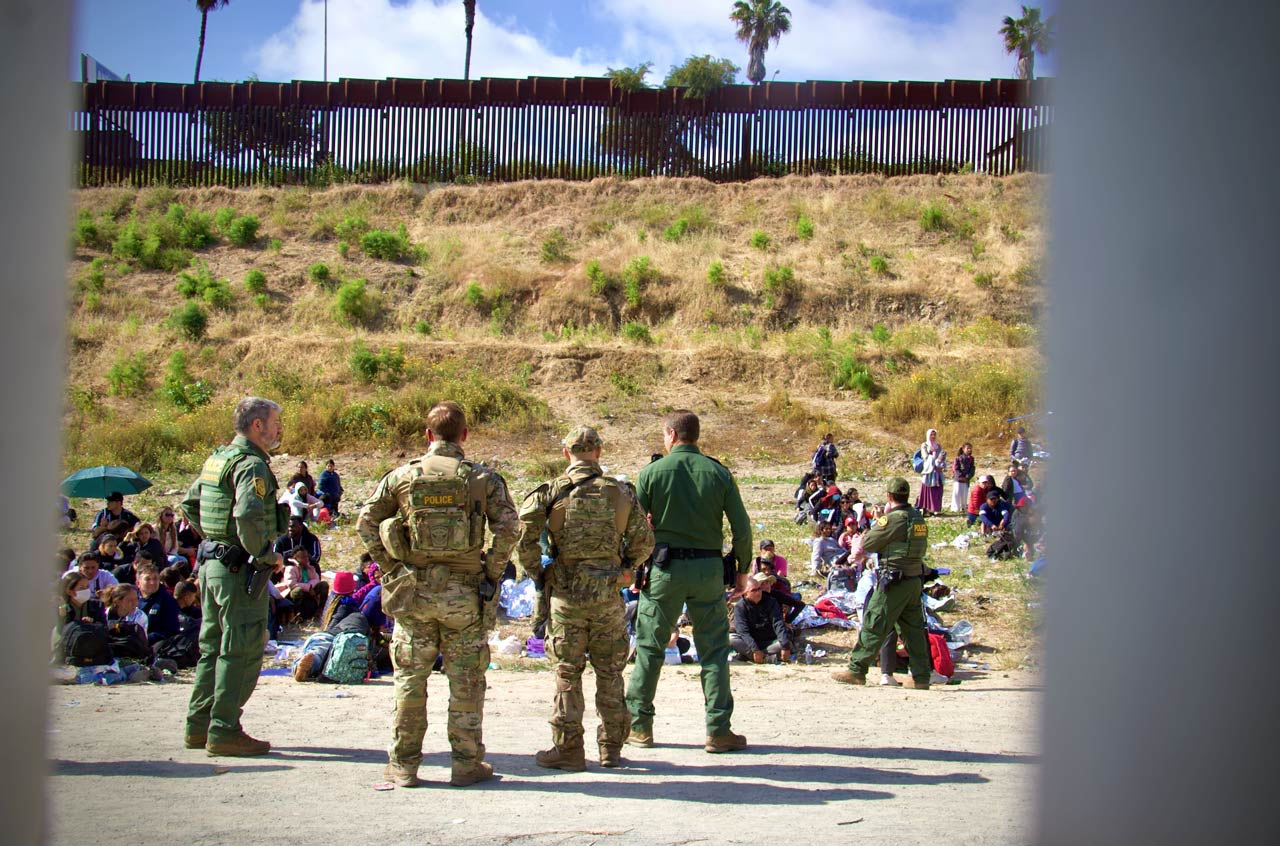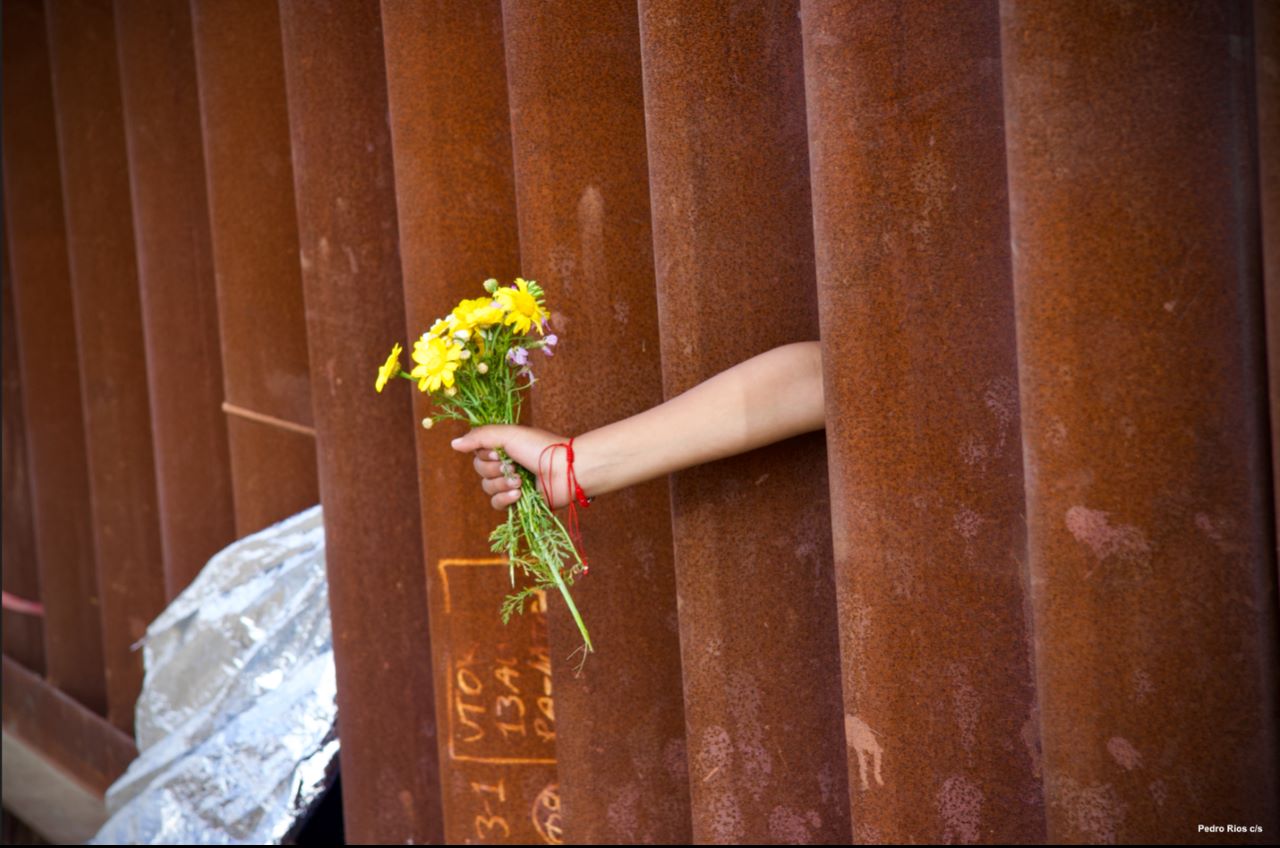
A migrant child hands flowers to people through the border barrier. Photo: Pedro Rios/AFSC
At California's southern border, two 30-foot-tall steel barriers slice through the landscape—dividing the United States from Mexico. Earlier this year, hundreds of migrants found themselves trapped between these two border walls as they tried to reach the U.S.Staff from AFSC and other human rights organizations first noticed a small group of migrants in the area in February. They had crossed the primary border wall from Mexico and were waiting to be picked up by U.S. Border Patrol agents for processing.
But instead of immediately bringing migrants into custody, as typically happens, Border Patrol agents left the migrants between the two walls for days— with no food, water, or protection from the cold. The space became an open-air holding cell.
“It was shocking to see them in between those walls,” says Nina Douglass, a volunteer with the Friends of Friendship Park Coalition, which includes AFSC. “Some migrants resorted to eating leaves from nearby bushes. Many of these people had already been through so much. Now they were being further traumatized.”
At the time, the U.S. was preparing for the end of Title 42, which was set to expire in May. Under that order, both the Trump and Biden administrations had used the COVID-19 pandemic as an excuse to deny hundreds of thousands of migrants their right to seek asylum in the U.S.
In place of Title 42, the Biden administration planned to institute what amounted to another asylum ban. “What we saw happening between those border walls was representative of a longtime pattern of abuse by Border Patrol,” says Pedro Rios, director of AFSC’s U.S.-Mexico Border Program. “Their modus operandi has always been to detain people in dangerous conditions. It’s also an extension of inhumane U.S. migration policies that have long denied migrants their human rights.”
For decades, AFSC has worked to expose this widespread, systemic abuse. Border Patrol uses military-style enforcement tactics, equipment, and strategies to control the border, including ATVs, drone planes, and military helicopters. Border Patrol has an egregious history of responding to asylum seekers with violence, sometimes even leading to migrant deaths.
Detaining migrants between the border walls was yet another case of the agency’s abuse and neglect. But it was one case where community members in San Diego knew they could do something to make a difference.
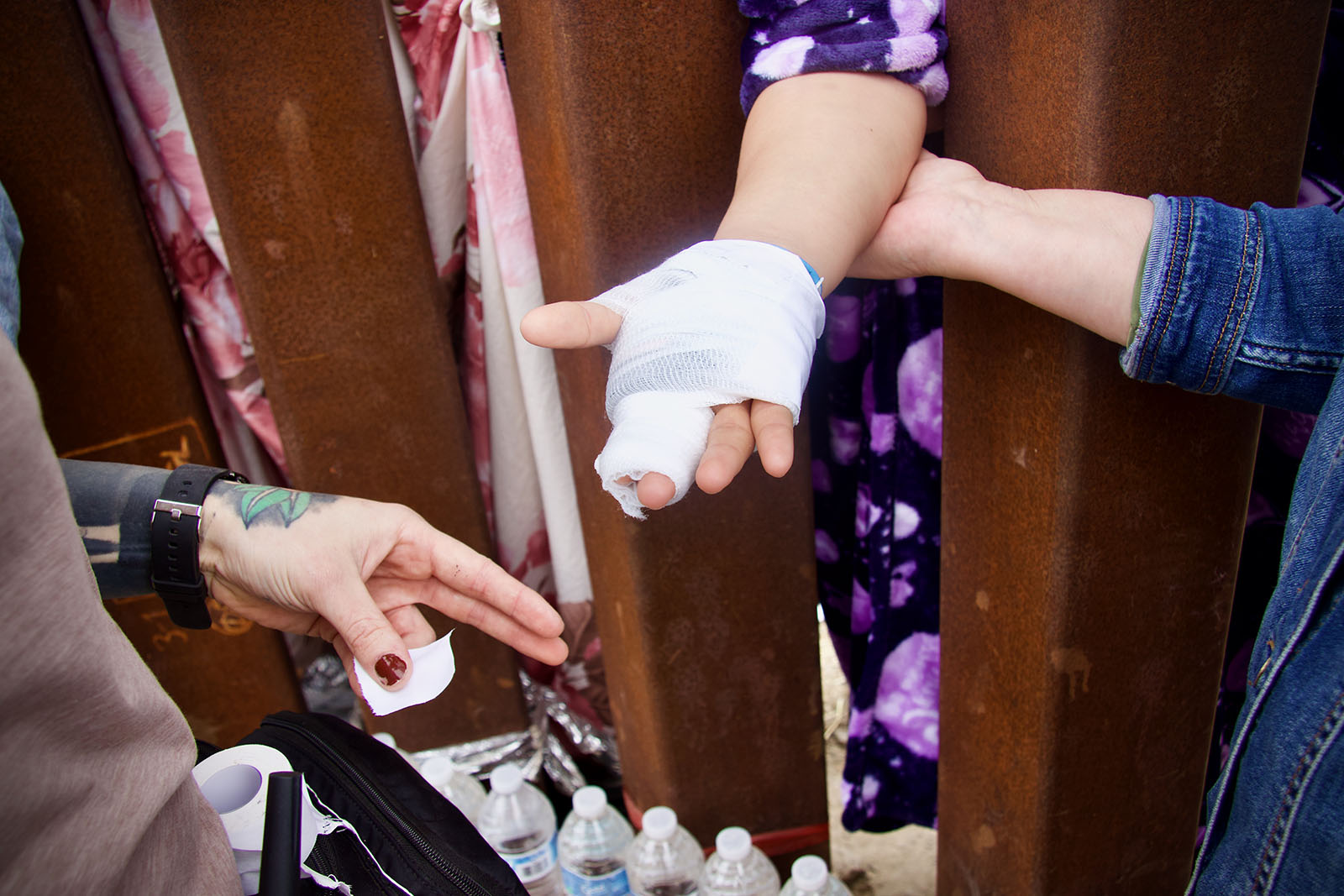
Volunteers treat a migrant's injuries through the border barrier. Photo: Pedro Rios/AFSC
With support from AFSC and Friends of Friendship Park, community members mobilized to distribute water, food, diapers, and baby formula through the fence. Meanwhile, AFSC contacted Border Patrol officials about the situation, urging them to provide a source of drinking water and a restroom service. In response, the agency provided a single portable toilet, which quickly became unusable without regular cleaning. The agency failed to deliver the water tank it promised, saying it would only attract more migrants to the area.
Over two weeks in May, the number of migrants trapped between the walls grew to over 400 people. Still, Border Patrol refused to do more than provide each migrant with two granola bars and two small bottles of water daily—leaving many dehydrated and hungry.
But as the need grew, so did the humanity and generosity of the community members. Pedro and AFSC team members Adriana Jasso and Benjamin Prado helped organize the response to ensure aid could reach everyone safely and equitably. They set up four stations that migrants could access by reaching through slots in the fence. One station offered a continuous source of water. A food station provided migrants with two meals per day. A third station allowed migrants to charge cell phones to stay in touch with loved ones at home and abroad. At the fourth station, people could get medical attention, including consulting with local doctors.
“As professional community organizers and human rights advocates, Pedro, Adriana, and Benjamin were able to analyze the situation and implement better organization,” Nina says. “They could also call on more community partners and others to help.”
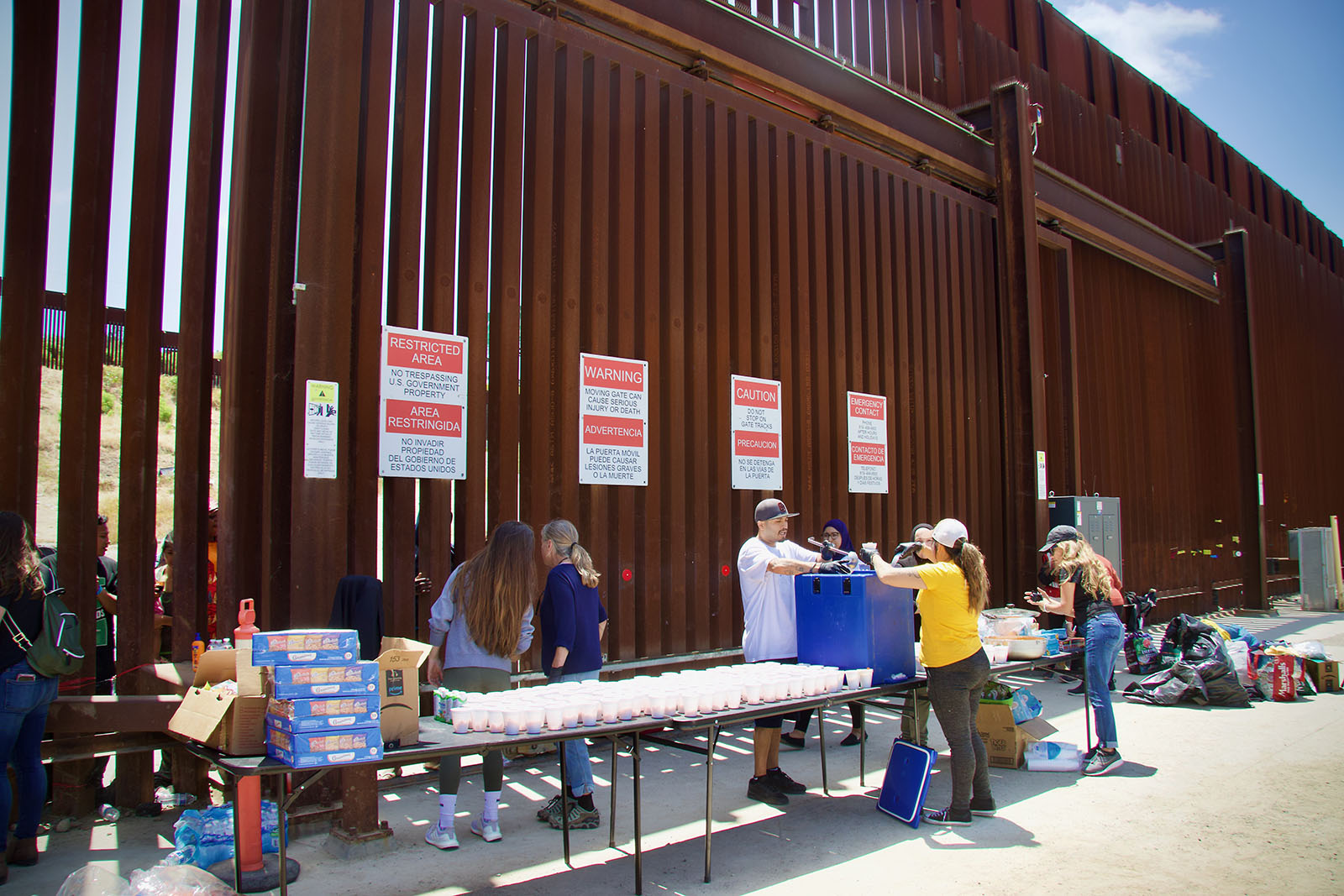
AFSC staff organized four different stations that migrants could access through the fence. The stations provided food, water, medical attention, and cell phone charging. Photo: Pedro Rios/AFSC
Each day, dozens of volunteers showed up to the wall, asking how they could contribute. One woman and her family provided home-cooked meals for hundreds of people. Another brought a truckload of tarps to protect people from the scorching sun. When Nina started an online gift registry for donations, her house soon overflowed with survival blankets, snack bars, and boxes of diapers.
Journalists from media outlets worldwide—including The New York Times, the BBC, and the Associated Press— reported on the humanitarian crisis and the community response. The community helped show the world what a more humane response to migrants seeking safety and a better life could look like.
Meanwhile, AFSC staff and others documented how Border Patrol’s neglect endangered migrant lives. In numerous cases, agents failed to provide emergency medical attention when needed. Among these cases: A woman from Jamaica who had suffered a miscarriage and was hemorrhaging was not provided medical attention for days, despite advocates raising the issue multiple times. An infant who stopped taking breastmilk, started vomiting, and was listless was only taken to a hospital after advocates’ intervention. A 79-year-old Colombian woman who fell off the border wall and suffered injuries to her leg only received medical attention after an entire day of phone calls from several advocates.
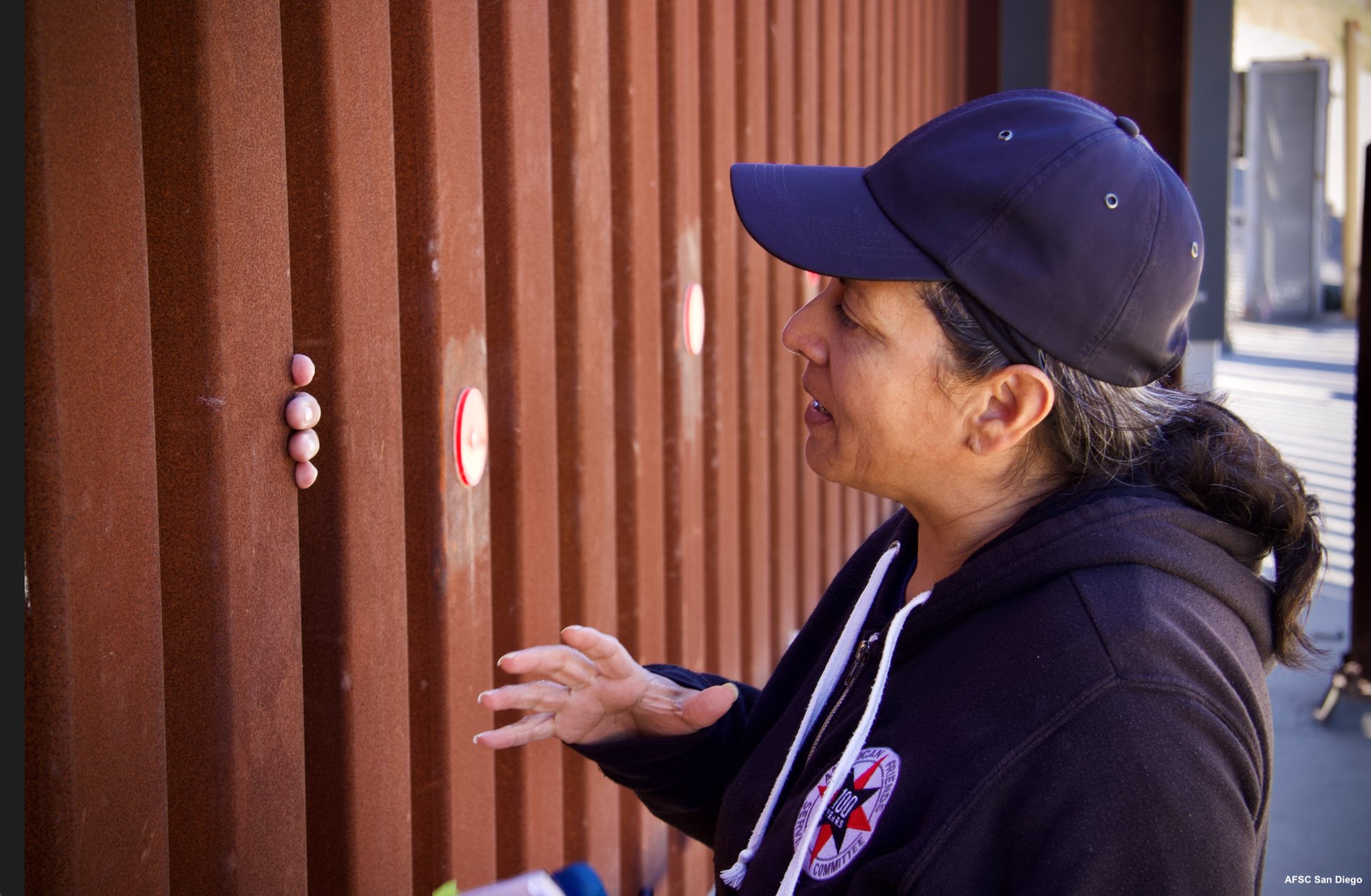
AFSC's Adriana Jasso speaks to a migrant through the border fence. Photo: Pedro Rios/AFSC
“I honestly believe the collective work we did saved lives,” Pedro says. In May of 2023, the Southern Border Communities Coalition—which includes AFSC—filed a formal complaint with the Department of Homeland Security’s Office for Civil Rights and Civil Liberties. It was filled with testimonies and photos from AFSC and partners. Over 20 pages, the complaint detailed the many ways that Border Patrol was violating migrants’ rights and putting their lives at risk. Soon after the complaint was filed, Border Patrol ended its practice of holding migrants in the open-air cell. Some migrants were detained and deported, while others were released in the U.S.
With the support of Universidad Popular, another human rights organization that supported migrants trapped between the border walls, AFSC staff conducted follow-up interviews with several people who were held at the site. We will publish a report on the findings by the end of 2023. This is part of our commitment to advocate for policies that protect the lives and rights of all migrants, wherever they’re from.
“Even the tiny act of handing someone water through the fence serves as a counter-narrative to U.S. policies that deny people their fundamental rights,” Adriana says. “Our community was able to challenge the inhumanity of this terrible migration system—and welcome people with dignity and respect.”
